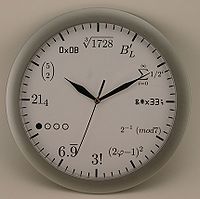Course:MATH103/Archive/2010-2011/207/Lectures/Lecture22
| Faculty of Science Department of Mathematics | |
|---|---|

| |
| Course Pages | |
| Course Policies | |
| Math Solvers | |
| Exams | |
| Quizzes | |
| Assignments | |
| Lectures | |
Lecture 22
Readings For This Lecture
- Chapter 9, pages 186 to 198
Summary
Group 3: Add a summary of the lecture in this space. Include examples, discussion, and links to external sources, if desired.
Exercises
1. A certain cylindrical water tank has a hole in the bottom, out of which water flows. The height of water in the tank at a certain time, , can be described by the differential equation
where is a positive constant. If the height of the water is initially , determine how much time elapses before the tank is empty.
2. The position of a particle is described by
.
Find the position as a function of time given that the particle starts at initially. Where is the particle when ? At which position(s) is the particle moving the fastest? The slowest?
3. Muscle cells are known to be powered by filaments of the protein actin which slide past one another. The filaments are moved by cross-bridges of myosin, that act like little motors, which attach, pull the filaments, and then detach. Let be the fraction of myosin cross-bridges that are attached at time . A model for cross-bridge attachment is: where are constants. Solve this differential equation and determine the fraction of attached cross-bridges as a function of time . What value does approach after a long time? Suppose and . Starting from , how long does it take for 50% of the cross-bridges to become attached ?
4. A model for the velocity of a sky diver is Failed to parse (syntax error): {\displaystyle \tfrac{dv}{dt} = 9 − v^{2}} . What is this skydiver’s “terminal velocity”; that is, near what velocity will the sky diver eventually stabilize? Explain what happens if the initial velocity is higher than the terminal velocity. Starting from rest, how long will it take to reach half of the terminal velocity?
5. Consider the differential equation for Newton’s Law of Cooling
and the initial condition: . Give a physical interpretation of this differential equation. Solve this differential equation by the method of separation of variables i.e. find T (t). Interpret your result.
6. Let be the volume of a spherical cell that is expanding by absorbing water from its surface area. Suppose that the rate of increase of volume is simply proportional to the surface area of the sphere, and that, initially, the volume is . Find a differential equation that describes the way that changes. Use the connection between surface area and volume in a sphere to rewrite your differential equation in terms of the volume alone. Solve the differential equation to show how the volume changes as a function of the time. (Hint: recall that for a sphere, .)




















